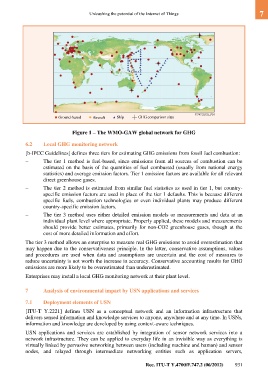Page 945 - Unleashing the potenti al of the Internet of Things
P. 945
Unleashing the potential of the Internet of Things 7
F.747.2(12)_F01
Ground-based Aircraft Ship GHG comparison sites
Figure 1 – The WMO-GAW global network for GHG
6.2 Local GHG monitoring network
[b-IPCC Guidelines] defines three tiers for estimating GHG emissions from fossil fuel combustion:
– The tier 1 method is fuel-based, since emissions from all sources of combustion can be
estimated on the basis of the quantities of fuel combusted (usually from national energy
statistics) and average emission factors. Tier 1 emission factors are available for all relevant
direct greenhouse gases.
– The tier 2 method is estimated from similar fuel statistics as used in tier 1, but country-
specific emission factors are used in place of the tier 1 defaults. This is because different
specific fuels, combustion technologies or even individual plants may produce different
country-specific emission factors.
– The tier 3 method uses either detailed emission models or measurements and data at an
individual plant level where appropriate. Properly applied, these models and measurements
should provide better estimates, primarily for non-CO2 greenhouse gases, though at the
cost of more detailed information and effort.
The tier 3 method allows an enterprise to measure real GHG emissions to avoid overestimation that
may happen due to the conservativeness principle. In the latter, conservative assumptions, values
and procedures are used when data and assumptions are uncertain and the cost of measures to
reduce uncertainty is not worth the increase in accuracy. Conservative accounting results for GHG
emissions are more likely to be overestimated than underestimated.
Enterprises may install a local GHG monitoring network at their plant level.
7 Analysis of environmental impact by USN applications and services
7.1 Deployment elements of USN
[ITU-T Y.2221] defines USN as a conceptual network and an information infrastructure that
delivers sensed information and knowledge services to anyone, anywhere and at any time. In USNs,
information and knowledge are developed by using context-aware techniques.
USN applications and services are established by integration of sensor network services into a
network infrastructure. They can be applied to everyday life in an invisible way as everything is
virtually linked by pervasive networking between users (including machine and human) and sensor
nodes, and relayed through intermediate networking entities such as application servers,
Rec. ITU-T Y.4700/F.747.2 (06/2012) 931

